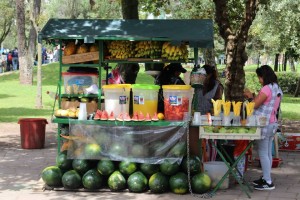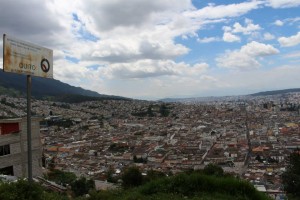
I went to Ecuador and made a Documentary
Over the mid semester break I was accepted to participate in a documentary program through Actuality Media. Actuality Media´s motto is ´Make movies. Change the world´. They strive to implement change through media practices. On their website they say, ‘While learning the art and practice of documentary filmmaking, our crews tell stories about positive social or environmental progress happening in developing communities around the world. By connecting media makers and change makers, we tell stories that matter.´ they work with NGO´s in a developing nation from Asia, Africa and South America. Groups of students from across the world participate learning media making skills and utilising them to communicate messages for social change. The students are paired into small groups of around 4 and have a month to create a 5-10 minute documentary in conjunction with their NGO. The films aren´t promotional but feature the work of the NGO in the story. There are two experienced media professionals who accompany the students for guidance and assistance.
I chose Quito, Ecuador for my program. The other options were Siem Reap in Cambodia or Kisumu in Kenya. This was my first experience documentary making and all my previous media experience had come directly through university. Our trip was made up of 12 students or recently graduated students predominantly from America but also Australia, Canada and a girl from a lot of different places. We were divided into groups of four and each chose their position in the crew. I was the director of our group. We were then paired with three NGOs. Ours was Asylum Access Ecuador. They work to give legal aid to refugees in Ecuador. Ecuador hosts an estimated 250,000 refugees which is the largest population of refugees in Latin America. Of those 250,000 98% of the refugees are Colombian. The conflict in Colombia has been happening since the mid-1960s. Many lives have been lost and there are approximately 5 million internally displaced Colombians. This combined with the discrimination from many Ecuadorians make life very difficult for Colombians in Ecuador. The other NGOs were CENNIT and the Manna Project.
The month’s layout consisted of two weeks for preproduction where we were to get to know our NGO and each other. We also conducted all our research and tried to understand the culture of where we were and the nature of the conflict. Then we had a week for production and a week for post-production. In media production this is quite a quick turnover. Especially considering the delicate and emotional nature of the content we were working through. Our work week was from Monday-Friday 9am to 6pm. Because of the tight schedule we often worked later in the night particularly in post-production week. We would either be working on site at our NGO or at an apartment we named ´Base Camp´ in which our instructors lived.

The instructors were helpful and taught me a lot about media production beyond our immediate documentary. Each respectively had years of industry experience and they were travelling the world to tutor each of the groups in Cambodia and Kenya as well. They were so valuable because each had a polar approach to film making. One was all about feeing and putting image before words. With a greater focus on emotions and the other had a greater focus on the technical side of putting together a film. In this way you could observe two different approaches to filmmaking and implement the one which best suited our group. We did have initial issues in post-production because of a difference in approaches and this brought to light the differing techniques of every filmmaker. My way of approaching editing would be to start out with a director’s cut and everything out on the timeline where you can see it. My editor though much preferred to work by fully planning out a sequence before putting it into the final timeline. It was a really interesting situation to be working in a group in professional roles and learning how to work together with everyone’s different processes.
I´m a naturally an introverted person so for me to step into the role of the director took time and some push from my crew members. This was my second experience of directing. Previously I had directed the short film produced for Film-TV 1. When I consider that short film now I can see a lot of things that I could´ve improved in that role. I needed to be more forceful and more confident in my creative decisions. Most people in my group had a little experience being in a professional film environment so when I made a decision they were followed. Through this I saw creative decisions I had made implemented and eventually being useful to the creation of our documentary. During production week I fell ill with a 48hour fever which everyone on our trip encountered at one point or another. This meant that when I returned I struggled to direct as I had before because I´d missed two days of shooting. Overall the effect wasn´t too bad because we´d previously created a shot list and story board. I’m definitely worst at directing the actual shoot and taking charge on set. In pre-production and post-production I felt very comfortable as the director.
Another very valuable aspect of this trip which I learnt a lot from was the other people involved. All of the others were older than me and therefore further through their courses, some had even graduated already. This meant that each person brought a lot of industry and technical knowledge to the table and in this way we could help each other learn and develop. The majority of the other students on the trip were from North America and so they had very broad experience including professional Hollywood films and large documentary production companies.
One of the hardest parts of the documentary was the language barrier. Within our group we had quite limited Spanish and so we required a translator to accompany us to all interviews and also in the editing suite. We were lucky to have such a good translator as some of the other groups found they were missing the crux of the interview due to inadequate translation and it got to post-production and they found they had a much more powerful story than they had thought. Another difficulty we faced was safety. Around the base of our NGO was a hub for the drug trade and also gang violence and mugging being a popular tourist destination. Our protagonist’s home was also in a dangerous neighbourhood and so whenever we were shooting or even just visiting we had to be very aware.
Something I didn´t really take into account was the emotional toll of working with such heavy content matter as the refugee experience. In the two weeks of pre-productions we conducted around 10 interviews with an array of refugees each with a different story of extortion, death-threats and danger. It was extremely emotionally taxing to hear the extent of what was happening in Colombia. Before going to Ecuador I was of the opinion that the Colombian conflict had really calmed down but because their economy has switched from coffee based to Cocaine based it’s just as bad as ever. In some interviews our subjects became really upset and it was difficult to comfort and understand them with the language barrier and how hard it was for them. Our protagonist, I can’t use his name online for the safety of his family, faced twofold of discrimination for being Colombian and for being black. He has a really powerful screen presence and was happy to share his and his family’s story.
This was an experience which quite frequently placed me outside my comfort zone not only as a media maker but in my experience as a traveller. I learnt a lot through the fast tracked month production and gained confidence in my abilities as a media producer. Overall it is an experience I will cherish forever.

